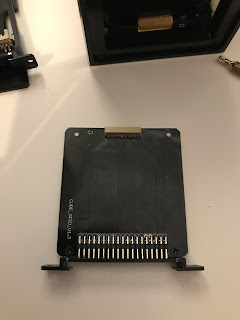Let's start the the cube itself. Of course it is a cube, with the logo on it:
There is a small switch on one of the sides which open the panel for the connectors.
The
top slot is for the GPIO connectors of the Raspberry PI. The slot containing 2 USB
ports probably are the Pi's aswell, but have yet to confirm that. The
microusb port with the two leds on the side is the main power feed. The
microusb port with only one led and a switch is also a power feed, but
behind that is also a slot for a battery. The empty
one is where the NFC antenna is located.
Opening
the box is quite complicated because everything is quite tight. First
thing first, remove all the 'facing' with a suction cup.
Now push out the GPIO board a tiny bit like the picture below. Also
push out the Raspberry Pi board. Both the GPIO and Raspberry Pi board
need to be moved out at the same time! It is quite hard to push them
out, because the housing is quite narrow and tight.
After
that you are able to push out all the other boards. Except for the last
one, don't push out the last slot. You are not able to get that one out without damaging it!
Some pictures of all of the boards, first the GPIO board
Next the Raspberry Pi board:
The micro usb port board, containing the 433 mhz and other RF communication chips
The other microusb port board, as you can see, their is space left for a battery:
And the almost empty housing:
So, if we look at the board what kind of hardware do we have?
- Raspberry Pi Zero
- With Samsung MicroSD 16GB
- Fn Link 6222D (RTL8822BU), WiFi chipset for 2.4Ghz and 5Ghz
- Arduino Micro Pro
- CC1011 Wireless transmitter (387-464 Mhz)
- NRF24L01 Wireless transmitter (2.4 Ghz)
- EM4095 125Khz RFID
- PN532 13,56Mhz RFID








